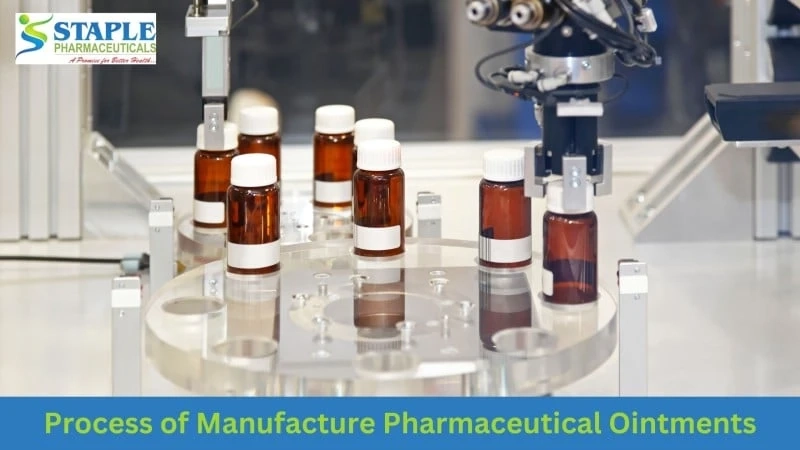An efficient technique to deliver active chemicals to the affected body area is through a cream or ointment. It treats pain, burns, itchiness, fungal infections, and skin issues. Oil in water (o/w) or water in oil (w/o) emulsions can be used as the ointment\'s foundation. Additionally, it might have emollients, lubricants, and waxes dispersed in oil.
Emulsifiers, stabilizers, and thickening agents make up the remaining ingredients. In some circumstances, colorants are also applied if necessary. Ointment production at a pharmaceutical manufacturing facility can be either automated or manual.
Automatic process
- The water phase is the initial stage. Water is added to the water phase vessel, which is then agitated. The stirrer is coupled to the vessel, which also has an insulated jacket covering it.
- Wax is poured into the wax vessel and swirled throughout the second step. It has an insulated jacket covering it, just like the water vessel, and a stirrer is fastened.
- Phase three is the mixing phase. A vacuum transfer technique moves melted wax and hot water to the mixing vessel.
- Active chemicals and medications are added to it while combining and swirling quickly.
- The material is circulated inside the jar to create a homogenous mixture.
- A bump pump moves the prepared ointment to the storage tank.
- It is transported to the filling area from the storage tank. The filling tube must be surrounded by hot water circulation to keep the material\'s viscosity at the proper level.
- The prepared material is moved to the filling machine\'s hopper. It has a measuring pump connected to it.
- The cream is placed inside the tube or container, then sealed and packaged before being sent out.
- After one production batch, all containers, tanks, and lining are thoroughly cleaned.
Manual process
- The human method follows the same steps as an automated one. The heating, stirring, and mixing are all done manually in this situation.
- After being adequately combined, it is transferred to a different chamber known as a colloid mill. It decreases particle size and homogenizes the mixture. When finished, it is moved to the storage tank.
- To get the mixture to flow freely, hot water is used.
- In the packing line, the ointment is sealed and packaged.
What is an ointment manufacturing plant?
The ointment production facility is designed to produce ointments and numerous cream-related products like gels, lotions, pastes, and other items like nature. The ointment production facility comprises many pieces of machinery and equipment for blending the components into a uniform mixture that is then packed into tubes or cans for storage using a tube-filling machine. The production of ointments begins with mixing the materials and finishes with the packaging of the finished product for sale.
Benefits of an ointment manufacturing facility
- Because equipment handles most of the job in an ointment production facility, labour costs are decreased.
- The fact that the ointment production facility has monitoring equipment to check the quality of each batch is a huge advantage.
- In a facility that makes ointments, reliability and consistency are very high standards.
- The ointment manufacturing facility has a higher production rate since procedures run concurrently without idle time.
- The manufacturing facility for ointments is flexible since it can produce a variety of ointments, lotions, creams, gels, and pastes using the same machinery.
Properties of the ointment manufacturing plant
- The wax phase is carried out in jacketed vessels at the ointment manufacturing facility.
- The ointment manufacturing facility uses jacketed vessels for both the water phase and the heating and cooling of the ingredients inside the manufacturing vessels.
- A vacuum system inside the ointment factory transfers mixtures from one tank to another.
- A planetary mixer is used in the ointment manufacturing facility to obtain a high level of emulsification and homogenization.
- The internal filters in the ointment production facility filter liquids before they are transported from one vessel to another.
- The manufacturing facility for ointments has a variable speed drive. This allows the propeller stirrer assembly to operate at various speeds.
- A control panel system is used in the ointment production plant to operate, monitor, and regulate various processes.
- The ointment manufacturing facility incorporates an illuminated viewport so that all the procedures can be seen visually.
Safety Feature
- The ointment manufacturing facility\'s installation of a temperature monitor and control system for jacketed vessels is a significant accomplishment.
- High-strength materials were used to construct the ointment manufacturing facility. Therefore, the likelihood of leaking or explosion is reduced.
- Internal pipelines throughout the manufacturing facility for ointments are all corrosion-resistant vessels.
- The ointment manufacturing facility has adequate sealing, which limits material leakage.
- To keep the containers safe while the procedure is being done, the ointment manufacturing plant features the appropriate interlocking devices.
Conclusion -
Here, we\'ve covered the processes used by pharmaceutical companies to make both automatic and manual ointments. The capacity for ointment production ranges from 200 kilogrammes to 500 kilogrammes per batch. Quality Control is crucial in both manual and automated processes. It guarantees that customers receive the most excellent product.


